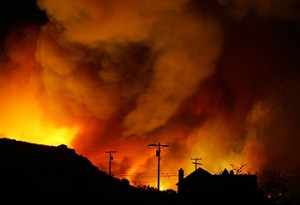By Gaye Levy
Guest writer for Wake Up World
Last month the news of wildfires in Michigan, New Mexico and elsewhere sent a wake up call to those who live in fire country. Draughts, lightening, human carelessness and simply freaks of nature can cause a wildfire. As more and more homes are built away from the cities close to wooded areas, the risk of loss from a wildfire increases. There is also a risk if you travel to a wooded recreational or wilderness area and a wildfire strikes.
This is not a topic I see mentioned much in the preparedness world. Mostly what you do hear about is the devastation and the total loss of property. But what about the loss of life and personal safety? Like any other catastrophe, preparing for wildfire is something that can and should be done using the basics tenants of preparing a kit (bug out bag), creating a family communications plan, and learning how to hunker down and shelter in place.
What causes a wildfire?
Wildfires often begin unnoticed and they are typically triggered by natural causes such as lightning, volcanic eruption, sparks from rock falls, and spontaneous combustion. Unfortunately, wildfires are also triggered by foolishness and carelessness on the part of humans. This includes arson, discarded cigarettes and sparks from equipment and and power lines.
The really bad thing about wildfires is that they spread quickly, igniting brush, trees, forests and the homes and businesses in their path.
Protecting yourself before the wildfire begins
As with all things preparedness, knowing the risks and anticipating the problem ahead of time will go a long way toward insuring your safety as well as the safety of your property. Here are some things you can do in anticipation that a wildfire just might happen.
- Maintain a 30 to 100 foot defensible space around your home to act as a fire break.
- Clear a 10 foot area around propane tanks and the barbecue.
- Regularly dispose of newspapers and rubbish.
- Regularly clean our debris from roof and gutters.
- Rake up leaves, dead limbs and twigs. Clear flammable vegetation from around and under structures.
- Mow grass regularly.
- Remove dead branches that extend over the roof.
- Thin a 15-foot space between tree crowns, and remove tree limbs within 15 feet of the ground.
- Ask the power company to clear branches from power lines.
- Stack firewood at least 100 feet away from your home. Clear combustible materials within 20 feet and use only UL-approved wood burning devices.
- Follow local burning regulations.
- Store flammable materials in approved safety cans.
- Inspect chimneys twice a year. Clean them at least once a year.
- Install smoke detectors on each level of your home and in each bedroom. Test them monthly and change the batteries twice a year.
- Teach each family member how to use a fire extinguisher (ABC type) and show them where it’s kept.
- Keep a ladder that will reach the roof.
- Purchase and keep handy household items that can be used as fire tools: a rake, hand saw or chain saw, bucket and shovel.
- Plant fire-resistant shrubs and trees. For example, hardwood trees are less flammable than pine, evergreen, eucalyptus or fir trees.
- Clear items that will burn from around the house, including wood piles, lawn furniture, barbecue grills, tarp coverings, etc. Move them outside of your defensible space.
- Review your homeowner’s insurance policy and also prepare/update a list of your home’s contents. Better yet, use your camera and make a video your home contents.
- Identify and maintain an adequate outside water source such as a small pond, cistern, well, swimming pool, or hydrant.
- Have a garden hose that is long enough to reach any area of the home and other structures on the property.
- Keep your cell phones charged and a full tank of fuel in your vehicle.
When Fire Threatens
- Listen to your radio for reports and evacuation information.
- Back your car into the garage or park it in an open space facing the direction of evacuation.
- Close doors and windows. Leave the key in the ignition. Close garage windows and doors, but leave them unlocked. Disconnect automatic garage door openers.
- Confine pets to one room. Plan for their care if you must evacuate.
- Arrange for temporary housing outside the threatened area.
During a Wildfire
- Take shelter at temporary housing at a friend or relative’s home outside the threatened area in case you need to evacuate. (This is where advance planning is important.)
- Wear protective clothing – sturdy shoes, cotton or woolen clothes, long pants, a long-sleeved shirt, gloves and a handkerchief to protect your face.
- Close outside attic, eaves and basement vents, windows, doors, pet doors, etc. Remove flammable drapes and curtains. Close all shutters, blinds or heavy non-combustible window coverings to reduce radiant heat.
- Close all doors inside the house to prevent draft. Open the damper on your fireplace, but close the fireplace screen.
- Shut off any natural gas, propane or fuel oil supplies at the source.
- Connect garden hoses. Fill any pools, hot tubs, garbage cans, tubs or other large containers with water.
- Place lawn sprinklers on the roof and near above-ground fuel tanks. Wet the roof.
- If you have gas-powered pumps for water, make sure they are fueled and ready.
- Place a ladder against the house in clear view.
- Disconnect any automatic garage door openers so that doors can still be opened by hand if the power goes out. Close all garage doors.
- Place valuable papers, mementos and anything “you can’t live without” inside the car in the garage, ready for quick departure. Any pets still with you should also be put in the car.
- Move flammable furniture into the center of the residence away from the windows and sliding-glass doors.
- Turn on outside lights and leave a light on in every room to make the house more visible in heavy smoke.
- Leave doors and windows closed but unlocked. It may be necessary for firefighters to gain quick entry into your home to fight fire.
- If advised to evacuate, do so immediately.
- Tell someone when you are leaving and where you are going.
- If you evacuate your home, place a note on the door indicating when you left and where you are going. If you absolutely must leave pets in the home, place a sign on the window saying PET INSIDE.
- Take your disaster supplies kit (bug out bag) with you.
- If you do find yourself trapped by wildfire inside your home, stay inside and away from outside walls. Close doors, but leave them unlocked. Keep your entire family together and remain calm.
After a Wildfire
When the fire has been contained, there are still some things you need to do to insure your safety.
- If you remained at home, check the roof immediately after the fire danger has passed. Put out any roof fires, sparks or embers. Check the attic for hidden burning sparks.
- For several hours after the fire, maintain a “fire watch.” Re-check for smoke and sparks throughout the house.
- If you detect heat or smoke when entering a damaged building, evacuate immediately.
- Avoid damaged or fallen power lines, poles and downed wires.
- Watch animals closely and keep them under your direct control. Hidden embers and hot spots could burn your pets’ paws or hooves.
- Follow public health guidance on safe cleanup of fire ash and safe use of masks.
- Wet debris down to minimize breathing dust particles.
- Wear leather gloves and heavy soled shoes to protect hands and feet.
- Discard any food that has been exposed to heat, smoke or soot.
- Do NOT use water that you think may be contaminated to wash dishes, brush teeth, prepare food, wash hands, make ice or make baby formula.
- Remain calm. Pace yourself. You may find yourself in the position of taking charge of other people. Listen carefully to what people are telling you, and deal patiently with urgent situations first.
The Final Word
Given wind and the right conditions, wildfires can move quicker than you can run. That means the best and the surest way to survive a wildfire is to escape well in advance. This is not to say that destruction by wildfire is preventable – what it says is that your personal safety, comfort and survival can be predicted and insured. by being prepared and getting out of dodge.
Do not be cavalier about wildfires – they can not only be costly, but also deadly.
For more information, FEMA has a excellent nine page brochure Wildfires: Are You Prepared. I highly recommend that you get a copy and keep it with the other documents in your preparedness library.
Enjoy your next adventure through common sense and thoughtful preparation!
Gaye
About the Author
Gaye Levy lives and teaches the principles of a sustainable, self-reliant and stylish lifestyle through emergency preparation and disaster planning. She does this through her website at BackdoorSurvival.com, an online preparedness blog that provides lifestyle tools, tips, and thoughts to guide you through the back door of life in the 21st century. With an emphasis on prepping and survival, she writes about and shares practical, thoughtful, and inspirational tools for survival in uncertain times.
Backdoor Survival is currently listed on the Survival Top 50. In addition, Gaye is a frequent guest on the Preparedness Radio Network and the soon to be author of a book on 21st century preparedness. Also known as SuvivalWoman, Gaye speaks her mind and delivers her message with optimism and grace, regardless of mayhem swirling around us.
You can find Gaye through her website at Backdoor Survival, on the Backdoor Survival Page on Facebook, and as Survival Woman on Twitter.

If you've ever found value in our articles, we'd greatly appreciate your support by purchasing Mindful Meditation Techniques for Kids - A Practical Guide for Adults to Empower Kids with the Gift of Inner Peace and Resilience for Life.
In the spirit of mindfulness, we encourage you to choose the paperback version. Delve into its pages away from screen glare and notifications, allowing yourself to fully immerse in the transformative practices within. The physical book enriches the learning process and serves as a tangible commitment to mindfulness, easily shared among family and friends.
Over the past few years, Wake Up World has faced significant online censorship, impacting our financial ability to stay online. Instead of soliciting donations, we're exploring win-win solutions with our readers to remain financially viable. Moving into book publishing, we hope to secure ongoing funds to continue our mission. With over 8,500 articles published in the past 13 years, we are committed to keeping our content free and accessible to everyone, without resorting to a paywall.







